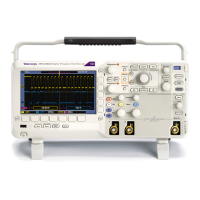Oscilloscope Reference Coupling
Coupling
All instruments and probes specify a maximum signal level. Do not exceed the limit, even momentarily, as
the input channel or probe may be damaged. Use external attenuators if necessary to prevent exceeding
the limits.
Coupling determines whether an input signal is directly connected to the input channel (DC coupling),
connected t
hrough a DC b locking capacitor (AC coupling), or not connected at all (GND coupling).
The input resistance of each input channel can be 1 MΩ or 50 Ω. To properly terminate signals when using
coaxial ca
bles, or to support active probes with different termination requirements, select the termination
in the Coupling control window.
All probe
s expect a specific coupling and input termination. Both coupling and input termination are
displayed on the screen. If the instrument determines the coupling and termination required by the probe,
either implicitly because of the TekProbe/TekVPI interface or through performing a probe compensation,
the instrument sets the required coupling and input termination.
Consider the following when you use 50 Ω termination with any channel:
The instrument does not accurately display frequencies under 200 k Hz if AC coupling is selected.
The ins
trument reduces the maximum volts per division setting for the channel to 1 V from 10 V (10 V
from 100 V with a 10X probe attached), since input amplitudes appropriate for the higher settings
would overload the 50 Ω input.
The instrument switches to 50 Ω termination and DC coupling if you connect an active probe. Active
probes also reduce the maximum volts per division.
What do you want to do next?
Lea
rn about the Vertical Setup window.
(see page 481)
Learn about the Termination control window. (see page 891)
680 DSA/DPO70000D, MSO/DPO/DSA70000C, DPO7000C, and MSO/DPO5000 Series

